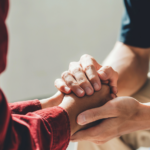Imagine living in a community where everyone participates in the care and support of neighbours experiencing palliative care, end-of-life care, grief and bereavement.
A community where young and old are socially connected to you and your neighbours; and where your social connections grow and thrive locally.
In towns and cities around Australia and the world, Compassionate Cities and Compassionate Communities are becoming a reality with community-led projects supporting community members.
‘This is the community saying we’re going to skill up so we can care for our own community members. And we’ve seen this in the COVID-19 pandemic. People are looking out for their neighbours and talking to each other’, says Northern Sydney PHN board member, and MHPN webinar facilitator, GP Dr Stephen Ginsborg, who is also on the board of the Council on the Ageing (NSW) and CCNB (Community Care Northern Beaches).
MHPN is supporting face-to-face networks to meet online while COVID-19 restrictions are in place.
As co-coordinator of the Sydney North Older Persons Mental Health Network, , last month Dr Ginsborg gave an online presentation about compassionate cities and compassionate communities which was co-produced with Sydney North Health Network (SNHN).
Dr Ginsborg explains that compassionate communities ‘can support us at many vulnerable times in our lives, as well as at end of life’.
‘The compassionate community raises literacy for death, suicide, ageing, mental health and more’.
According to American researcher, Julianne Holt-Lunstad, ‘There is robust evidence that social isolation and loneliness significantly increase risk for premature mortality, and the magnitude of the risk exceeds that of many leading health indicators. ‘Many nations around the world now suggest we are facing a ‘loneliness epidemic’. The challenge we face is what can be done about it’.
In the compassionate communities model, interdisciplinary collaboration occurs within the health system and beyond.
‘It’s at the heart of compassionate communities that there is collaboration. There are connections and conversation, everyone can talk to each other. It reaches right across our health system and our community structures’, says Dr Ginsborg.
Moreover, compassionate communities ‘should interweave First Nations knowledge with current compassionate community models to help create sustainable communities; and social, physical, spiritual and emotional wellbeing’, he says
‘First Nations cultures have survived on this continent for over 60,000 years, and prior to 1788, people were in better health than by most of today’s indicators. One of the ways that enabled families and communities to thrive in life and death were social structures based on self-care from which current social prescription of a compassionate community has much to learn’.
The Groundswell Project is a huge part of the Compassionate Communities movement that mental health practitioners need to know about, says Dr Ginsborg.
‘Groundswell works in the sites of grief, end-of-life and bereavement; and promotes having the conversation about dying. Many people don’t talk about dying. We suffer and fear but we don’t talk about it’, he says.
With a focus on prevention and early intervention at their core, Groundswell and its partners have the potential to develop communities that support the whole person throughout their lifespan.









